 W
WThe list of fish of the Black Sea consists of indigenous, and also introduced species.
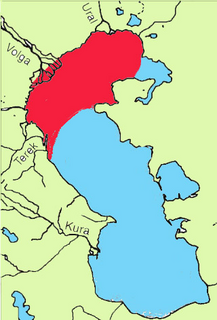 W
WAbdurahmanov's pugolovka is a brackishwater fish of family Gobiidae. It is found in the northern Caspian Sea and in the lower reaches of the rivers Volga and Terek. FishBase treats this taxa as a subspecies of the Azov tadpole goby (Benthophilus magistri abdurahmanovi.
 W
WArgyrosomus regius is a fish of the family Sciaenidae. It is similar in form to a European seabass, with a pearly-silver coloration and a yellow-coloured mouth. Length can range from 40–50 cm to 2 m long, with weights up to 55 kg.
 W
WArrow dragonet, also known as the arrow-headed darter dragonet, is a species of dragonet widespread in the Indo-West Pacific from Arabian Peninsula to the Philippines. Occurs in the Mekong delta of Viet Nam and probably also in Cambodia. This species grows to a length of 11 centimetres (4.3 in) TL. The arrow dragonet is a demersal species, which occurs on sandy substrates along coastlines, in estuaries, and in the lower courses of rivers where it feeds on worms, zooplankton and phytoplankton.
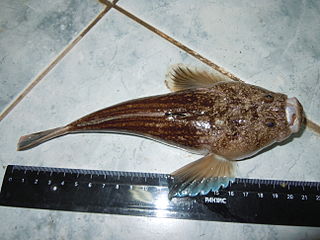 W
WAtlantic stargazer is a marine, subtropical fish of family Uranoscopidae. Its body is suited for living on the sea floor, and is one of few fish capable of bioelectrogenesis, or the ability to generate an electric charge.
 W
WThe Baer pugolovka is a species of goby widespread in the southern and central Caspian Sea, to Lenkoran in south. Also near the Chechen Island, Tyuleniy Islands, and in Bakhtemirovskaya Borozdina in north. This species occurs at depths of from 15 to 81 metres. Males can reach a length of 8 centimetres (3.1 in) TL while females only reach 6 centimetres (2.4 in) TL.
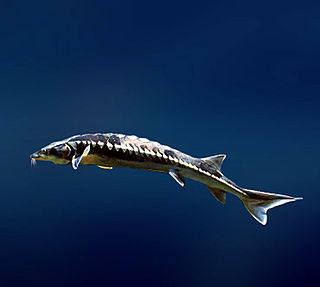 W
WThe bastard sturgeon, fringebarbel sturgeon, ship sturgeon, spiny sturgeon, or thorn sturgeon is a species of fish in the family Acipenseridae. Formerly abundant in the Black, Aral and Caspian seas, its range is now primarily limited to the Ural River, with possible relict populations in the Rioni River in Georgia and the Safid Rud in Iran. The healthiest population is one in Lake Balkhash in Kazakhstan, well outside its natural range, where they were introduced in the 1960s for commercial purposes. It has been reported that this fish has the highest relative fecundity for any sturgeon species.
 W
WBenthophilus ctenolepidus is a species of goby widespread along the southern coasts of the Caspian Sea: in the Gorgansky Bay, also from Absheron to Astara at south.
 W
WBenthophilus grimmi is a species of goby widespread in the northern Caspian Sea at depth 80 to 240 metres. This species is common from Chechen Island to Absheron Peninsula. This species can reach a length of 9.5 centimetres (3.7 in) TL. The specific name honours the Russian ichthyologist Oscar von Grimm (1845–1921),, who was Chief Inspector of Russian Fisheries in the Russian Empire who collected the type specimen.
 W
WBenthophilus leptocephalus is a deepwater species of goby widespread along the central Caspian Sea from the mouth of the Samur River to Türkmenbaşy and Hasan-Kuli. This species can reach a length of 5.4 centimetres (2.1 in) TL.
 W
WBenthophilus pinchuki, Pinchuk's pugolovka, is a species of gobiid fish found along the eastern and western coasts of the Caspian Sea, but absent on the middle part. This species has been recorded along the western coast from the Absheron to Iran, and along the eastern coast near the Cape Bely Bugor, Turkmenistan.
 W
WBenthophilus ragimovi is a deepwater species of gobiid fish found along the western coasts of the Caspian Sea, from the Chechen Island to Astara, Azerbaijan. It is one of the numerous species of benthophiline gobies endemic to the Ponto-Caspian region.
 W
WBrown meagre or corb is a species of croaker found in, the eastern Atlantic, Mediterranean Sea and Black Sea occurring in shallow waters and sandy bottoms. It is harvested for human consumption, especially in the Mediterranean.
 W
WThe Caspian goby is a species of fish endemic to the Caspian Sea where it is only found in brackish waters. It is the largest of the Caspian gobies, and at maximum may reach a length of 34.5 centimetres (13.6 in).
 W
WThe Caspian stellate tadpole-goby, also known as the starry goby, is a species of gobiid fish endemic to the Caspian Sea basin. It is widespread along all coasts of the Caspian Sea with exception of the central-eastern, and in the lowest part of the Volga River. In the southern part of the basin, it is mentioned near the Ogurja Ada, in the Gorgansky Bay, and in the Sefīd-Rūd River. This species can reach a length of 10 centimetres (3.9 in) SL.
 W
WThe Caspian tadpole goby is a species of goby which is widespread in the basin of the Caspian Sea, specifically in the near-estuary zone of the rivers and in small bays. It is a common species in the Volga River delta near Astrakhan, occurred in the deltas of rivers Terek, Ural, Samur. During the warmer months, this species prefers to live at depths of from .5 to 10 metres, moving in the colder months to depths of 20 to 25 metres. It can reach a length of 11.6 centimetres (4.6 in) TL.
 W
WThe chestnut goby is a species of goby found in the Mediterranean and Black Sea. In the Black Sea it is found in the Gulf of Varna, saline lagoons near Abrau, also near Novorossiysk and Sochi. This species occurs in shallow, coastal waters. It can reach a length of 6.6 centimetres (2.6 in) SL.
 W
WThe comber is a species of marine ray-finned fish from the family Serranidae, the sea basses. It is widely distributed in the eastern North and South Atlantic Oceans and into the southwestern Indian Ocean. It is caught for food and fishmeal in some parts of its range.
 W
WThe eastern tubenose goby is a species of gobiid fish native to fresh and brackish waters of the basins of the Sea of Azov and the Caspian Sea and has invaded the upper reaches of the Volga River from its native occurrence in the delta. This species prefers slow flowing rivers or still waters with plentiful rocks or vegetation. It can reach a length of 9 centimetres (3.5 in) SL. It is probably the same species as that recently treated as Proterorhinus semipellucidus.
 W
WThe flatsnout goby is a species of goby endemic to the Black Sea where it is mostly known from inshore waters amongst rocks and boulders. It is occasionally found offshore over areas with gravel substrates. This species can reach a length of 22.5 centimetres (8.9 in) TL.
 W
WThe monkey goby is a species of goby native to the basins of the Black Sea and the Sea of Azov.
 W
WThe round goby is a euryhaline bottom-dwelling goby of the family Gobiidae, native to central Eurasia including the Black Sea and the Caspian Sea. Round gobies have established large non-native populations in the Baltic Sea, several major Eurasian rivers, and the North American Great Lakes.
 W
WThe granular pugolovka is a species of gobiid fish widespread in the Caspian Sea. It is a small fish, with a length up to 5.6 centimetres (2.2 in) TL. It was listed as Least Concern by the IUCN in 2008: there are no known major threats. Granular pugolovkas are very abundant in their habitat due to their size and lack of natural predators. The common name 'pugolovka' is a Ukrainian word for tadpole.
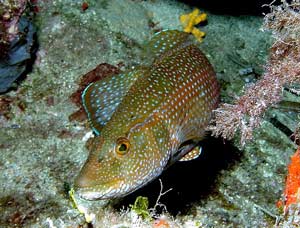 W
WLabrus viridis is a species of wrasse native to the eastern Atlantic Ocean from Portugal to Morocco, as well as through the Mediterranean Sea to the Black Sea. This species is found around rocky reefs amongst the rocks or in eelgrass beds. It can reach 47 cm (19 in) in standard length, though most do not exceed 37.5 cm (15 in). It is one of several species called green wrasse.
 W
WThe leaping mullet is a species of fish in the family Mugilidae. It is found in coastal waters and estuaries in the northeast Atlantic, ranging from Morocco to France, and including the Mediterranean and Black Sea. It has been introduced to the Caspian Sea.
 W
WLipophrys trigloides is a species of combtooth blenny. Distributed in the Eastern Atlantic along the coasts of France (Brittany), the Iberian Peninsula, Morocco, the Mediterranean and the Sea of Marmara southwards to Senegal, the Canary Islands and Madeira. Marine subtropical demersal fish, up to 13 cm length.
 W
WThe mushroom goby is a species of goby native to the Black Sea where it can be found along the coasts from Bulgaria to the Crimea. Mostly a species of marine and brackish waters, it is known to enter fresh waters in the delta of the Danube River. This species prefers inshore waters with rocks or fallen trees. This species can reach a length of 20 centimetres (7.9 in) TL.
 W
WSnake blenny is a fish species in the family Ophidiidae. Widespread in the Eastern Atlantic from the southern England to Senegal and the northern Mediterranean Sea. It is a marine subtropical demersal fish, up to 25 cm long.
 W
WThe Persian sturgeon is a species of fish in the family Acipenseridae. It is found in the Caspian Sea and to a lesser extent the Black Sea and ascends certain rivers to spawn, mainly the Volga, Kura, Araks and Ural Rivers. It is heavily fished for its flesh and its roe and is limited in its up-river migrations by damming of the rivers. Young fish feed on small invertebrates, graduating to larger prey such as crabs and fish as they grow. The threats faced by this fish include excessive fishing with the removal of immature fish before they have bred, damming of the rivers, loss of spawning areas and water pollution. The International Union for Conservation of Nature has listed the fish as critically endangered and has suggested that the increased provision of hatcheries could be of benefit.
 W
WPonticola bathybius is a species of goby endemic to the Caspian Sea, where it occurs in depths down to 200 metres (660 ft). It is strictly confined to the brackish-water basin and does not enter fresh waters. It can grow up to a length of 25 centimetres (9.8 in) TL.
 W
WPonticola kessleri, the bighead goby or Kessler's goby, is a species of goby native to Eurasia. The bighead goby is a Ponto-Caspian relict species. It inhabits the fresh and oligohaline waters, with mineralisation from 0-0.5‰ up to 1.5-3.0‰.
 W
WCallionymus risso, Risso's dragonet, is a species of dragonet native to the Mediterranean Sea as well as the Black Sea and rarely found off of Portugal in the Atlantic Ocean. This species can be found at depths of from 15 to 150 metres. Males of this species grows to a length of 11 centimetres (4.3 in) TL while females reach a length of 6.5 centimetres (2.6 in).
 W
WRoche's snake blenny is a fish species in the genus Ophidion and the family Ophidiidae. Widespread in the Mediterranean Sea in western and northern regions, also in the Black Sea, Sea of Marmara and it has been recorded in the Atlantic. Marine subtropical demersal fish, up to 29.3 centimetres (11.5 in) long. The specific name honours the Swiss physician and naturalist François-Etienne Delaroche (1780-1813), who wrote about the distinctive swim-bladder anatomy of Ophidion barbatum in 1809.
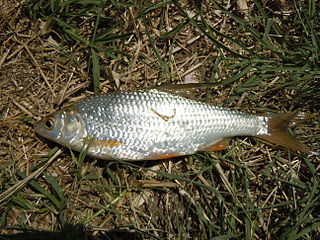 W
WRutilus heckelii is a species of roach, a genus in the family Cyprinidae. This species occurs in the Black Sea and Caspian Sea basins, the Azov Sea itself, and even in drainage areas of the White Sea.
 W
WCallionymus pusillus, the Sailfin dragonet, is a species of dragonet common in the Eastern Atlantic, where it occurs on the Portuguese coast to as far north as Lisbon and south to Morocco, and also in the northern Mediterranean including the Adriatic, Aegean and Black seas as well as the coastsLebanon and Israel. It occurs on the southern Mediterranean shore as far east as Tunisia Males of this species grows to a length of 14 centimetres (5.5 in) TL while females reach a length of 10 centimetres (3.9 in) TL. In the areas of the Mediterranean where it occurs it is one of the commonest dragonet species, as it is the only species that has been recorded within many protected areas. It is a benthic species which occurs in shallow waters and prefers sandy bottoms down to 100 metres (330 ft). The males are territorial, aggressively defend their territories from other males and like other dragonets this species undergoes complex breeding behaviour which has 4 phases. This starts with courtship, the male and female then form a pair before ascending to the surface where they release eggs and milt. The spawning season runs from May to August in the Mediterranean and the eggs and larvae are pelagic. This species feeds mainly on small benthic invertebrates such as worms and small crustaceans.
 W
WSalaria basilisca is a species of combtooth blenny found in the Mediterranean Sea near Tunisia and Turkey, also in the Adriatic Sea. This species reaches a length of 18 centimetres (7.1 in) TL. It is found among seagrass, sometimes where there is a rocky substrate. The male guards the eggs produced by several females. They are protogynous hermaphrodites with individuals being females while young changing to males later.
 W
WThe short-snout pugolovka is a deepwater species of goby widespread in the central part of the Caspian Sea at the depth of 40 to 150 metres, with salinity 10–13.5‰. It is found along the western coast of the Caspian Sea from the mouth of the Sulak River to Baku at south. This species can reach a length of 4 centimetres (1.6 in) TL.
 W
WThe Syrman goby is a species of goby native to marine, brackish and probably fresh waters of the Black Sea, the Sea of Azov and the Caspian Sea basins. They inhabit inshore waters with substrates composed of shell fragments, sand, mud or muddy sand. This species can reach a length of 24.5 centimetres (9.6 in) TL.
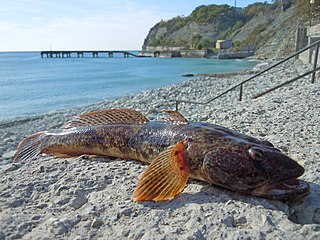 W
WMesogobius batrachocephalus, the knout goby or toad goby, is one of the species of gobiid fish native to the Black Sea and the Sea of Azov basins. It lives in estuaries and brackish water lagoons, occasionally in fresh waters, such as the coastal Lake Siutghiol in Romania. It prefers areas near cliffs with sandy, shelly or rocky substrates at depths of from 20 to 60 metres, sometimes down to 100 metres (330 ft). The knout goby is a piscivore. It can reach a length of 34.5 centimetres (13.6 in) SL and weight of 600 grams (1.3 lb). Maximum known age is eight years.
 W
WAphia minuta, the transparent goby, is a species of the goby native to the northeastern Atlantic Ocean where it can be found from Trondheim, Norway to Morocco. It is also found in the Mediterranean, Black Sea and the Sea of Azov. It is a pelagic species, inhabiting inshore waters and estuaries. It can be found at depths of from the surface to 97 metres (318 ft), though it is usually found at 5 to 80 metres, over sandy and muddy bottoms and also in eelgrass beds. This species can reach a length of 7.9 centimetres (3.1 in) TL. It is an important species to local commercial fisheries. It is currently the only known member of its genus.
 W
WTripterygion melanurum is a species of fish in the family Tripterygiidae, the threefin blennies. It is widespread in the Mediterranean Sea, where it occurs around the Balearic Islands and off the coasts of southern Sardinia, Algeria, Tunisia, Israel, Lebanon, Greece, Cyprus, and southern Turkey. It is a marine subtropical demersal fish measuring up to 5.3 centimetres (2.1 in) in length.